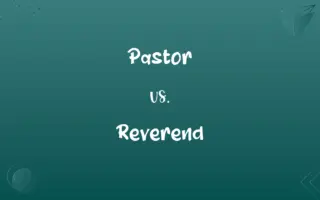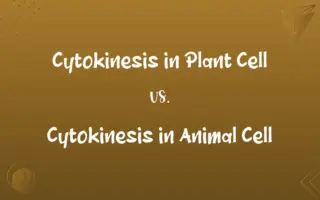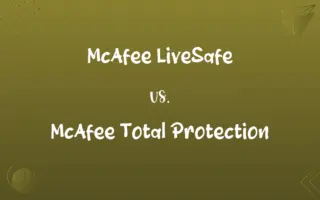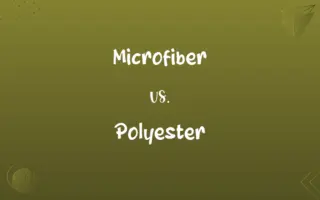In Situ Conservation vs. Ex Situ Conservation: Know the Difference

By Shumaila Saeed || Published on February 8, 2024
In situ conservation involves protecting species in their natural habitats, while ex situ conservation involves safeguarding species outside their natural environments.
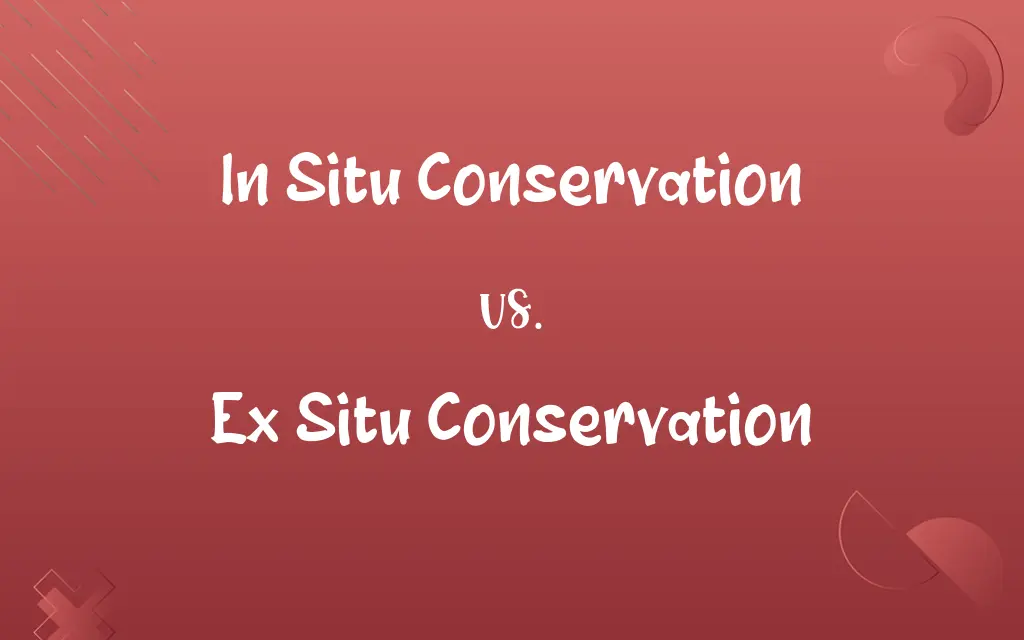
Key Differences
In Situ Conservation involves protecting and maintaining wildlife species in their natural habitats. This approach focuses on the preservation of ecosystems and natural processes, providing the conditions for species to live and reproduce in their original environments. Ex Situ Conservation, in contrast, refers to the preservation of species in artificial or human-controlled settings, such as zoos, botanical gardens, or seed banks, away from their natural habitats.
Shumaila Saeed
Feb 08, 2024
In Situ Conservation emphasizes the conservation of genetic diversity within the natural context, maintaining not only individual species but also the relationships and interactions they have with their environment and other species. It supports the overall integrity of ecosystems. Ex Situ Conservation is often used when in situ methods are not viable, for critically endangered species, or when natural habitats are too degraded to support certain species.
Shumaila Saeed
Feb 08, 2024
An advantage of In Situ Conservation is that it allows for the preservation of a broad range of biodiversity, including not just the species of interest but also the myriad of other organisms that form part of the ecosystem. Ex Situ Conservation, while more limited in preserving the broader ecological context, plays a crucial role in species recovery programs and can provide a repository for genetic material and research.
Shumaila Saeed
Feb 08, 2024
In Situ Conservation strategies include the establishment of protected areas, like national parks and wildlife reserves, which serve as safe havens for endangered species. Ex Situ Conservation methods include captive breeding programs, botanical gardens, and gene banks, which ensure the survival of species and genetic diversity outside their natural environments.
Shumaila Saeed
Feb 08, 2024
The key goal of In Situ Conservation is to enable species to continue to evolve and adapt within their natural ecological context, helping to ensure long-term sustainability. Ex Situ Conservation is typically more focused on the short-term preservation of individual species, particularly in emergency situations where immediate action is required to prevent extinction.
Shumaila Saeed
Feb 08, 2024
ADVERTISEMENT
Comparison Chart
Methods
Protected areas, habitat management
Zoos, botanical gardens, gene banks
Shumaila Saeed
Feb 08, 2024
Biodiversity Impact
Preserves broad ecosystem biodiversity
Focuses on specific species, less on ecosystem
Shumaila Saeed
Feb 08, 2024
Goal
Long-term sustainability in natural context
Short-term preservation, research, and breeding
Shumaila Saeed
Feb 08, 2024
ADVERTISEMENT
In Situ Conservation and Ex Situ Conservation Definitions
In Situ Conservation
In situ conservation is essential for ecosystem health and stability.
Healthy coral reefs are maintained through in situ conservation efforts.
Shumaila Saeed
Jan 17, 2024
Ex Situ Conservation
Ex situ conservation supports research and education.
The research institute uses ex situ conservation for studying endangered species.
Shumaila Saeed
Jan 17, 2024
In Situ Conservation
In situ conservation involves protecting species in their natural habitats.
The national park was established for the in situ conservation of endangered wolves.
Shumaila Saeed
Jan 17, 2024
Ex Situ Conservation
Ex situ conservation involves preserving species outside their natural habitats.
The zoo's breeding program is a form of ex situ conservation for tigers.
Shumaila Saeed
Jan 17, 2024
In Situ Conservation
It includes creating protected areas like wildlife sanctuaries.
The new sanctuary is a prime example of in situ conservation for birds.
Shumaila Saeed
Jan 17, 2024
ADVERTISEMENT
Ex Situ Conservation
It includes activities like captive breeding and botanical gardens.
Botanical gardens play a crucial role in ex situ conservation of rare plants.
Shumaila Saeed
Jan 17, 2024
In Situ Conservation
It emphasizes maintaining natural ecological processes and biodiversity.
In situ conservation in the wetlands helps preserve the entire aquatic ecosystem.
Shumaila Saeed
Jan 17, 2024
Ex Situ Conservation
Ex situ conservation is used when in situ methods are insufficient.
For critically endangered frogs, ex situ conservation is their last hope.
Shumaila Saeed
Jan 17, 2024
In Situ Conservation
In situ conservation aims to ensure species can evolve in their native environments.
Through in situ conservation, the native forest species continue to adapt and thrive.
Shumaila Saeed
Jan 17, 2024
Ex Situ Conservation
It provides a way to safeguard genetic diversity.
Seed banks are a form of ex situ conservation, preserving plant genetic material.
Shumaila Saeed
Jan 17, 2024
Repeatedly Asked Queries
What is In Situ Conservation?
In situ conservation refers to the protection of wildlife and natural resources in their natural habitats.
Shumaila Saeed
Feb 08, 2024
How do In Situ and Ex Situ Conservation differ?
in situ is conservation in the natural environment, while ex situ is conservation in a controlled, often artificial environment.
Shumaila Saeed
Feb 08, 2024
Why is Ex Situ Conservation important?
It provides a safety net for species at risk of extinction, allowing for breeding and research in a controlled setting.
Shumaila Saeed
Feb 08, 2024
What is Ex Situ Conservation?
Ex situ conservation involves conserving wildlife and natural resources outside their natural habitats, like in zoos or botanical gardens.
Shumaila Saeed
Feb 08, 2024
Why is In Situ Conservation important?
It maintains biodiversity in the natural ecosystem, ensuring ecological balance and conservation of the natural habitat.
Shumaila Saeed
Feb 08, 2024
Can you give an example of Ex Situ Conservation?
Zoos, aquariums, and seed banks are typical examples of ex situ conservation.
Shumaila Saeed
Feb 08, 2024
How does Ex Situ Conservation support biodiversity?
It allows for controlled breeding programs, research, and can reintroduce species into the wild.
Shumaila Saeed
Feb 08, 2024
What are the challenges of In Situ Conservation?
Habitat degradation, human-wildlife conflict, and legal enforcement are significant challenges.
Shumaila Saeed
Feb 08, 2024
Can you give an example of In Situ Conservation?
National parks and wildlife reserves are prime examples of in situ conservation.
Shumaila Saeed
Feb 08, 2024
How does In Situ Conservation benefit local communities?
It often promotes eco-tourism and sustains local economies, while also preserving cultural heritage.
Shumaila Saeed
Feb 08, 2024
Can In Situ and Ex Situ Conservation be combined?
Yes, combining both methods can be very effective in comprehensive conservation strategies.
Shumaila Saeed
Feb 08, 2024
How is technology used in In Situ Conservation?
Drones, GPS tracking, and remote sensing are some technologies used in monitoring and research.
Shumaila Saeed
Feb 08, 2024
Is In Situ Conservation always preferable to Ex Situ Conservation?
Not always. Each method has its own advantages and is suitable for different conservation needs.
Shumaila Saeed
Feb 08, 2024
Does In Situ Conservation help against climate change?
Yes, by preserving natural habitats, it plays a crucial role in mitigating climate change.
Shumaila Saeed
Feb 08, 2024
What role do humans play in In Situ Conservation?
Humans play a vital role through policy making, habitat management, and raising awareness.
Shumaila Saeed
Feb 08, 2024
What role do humans play in Ex Situ Conservation?
Humans are central, involved in care, breeding, research, and education programs.
Shumaila Saeed
Feb 08, 2024
How is technology used in Ex Situ Conservation?
Advanced breeding techniques, gene banks, and climate-controlled environments are some examples.
Shumaila Saeed
Feb 08, 2024
Can Ex Situ Conservation specimens be reintroduced into the wild?
Yes, but it requires careful planning to ensure their survival and adaptability.
Shumaila Saeed
Feb 08, 2024
What is the future of Conservation methods?
A blend of traditional knowledge, community involvement, and modern technology will likely shape future conservation strategies.
Shumaila Saeed
Feb 08, 2024
What are the challenges of Ex Situ Conservation?
High costs, ethical concerns, and sometimes limited genetic diversity in captive populations are key challenges.
Shumaila Saeed
Feb 08, 2024
Share this page
Link for your blog / website
HTML
Link to share via messenger
About Author
Written by
Shumaila SaeedShumaila Saeed, an expert content creator with 6 years of experience, specializes in distilling complex topics into easily digestible comparisons, shining a light on the nuances that both inform and educate readers with clarity and accuracy.




